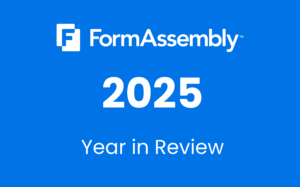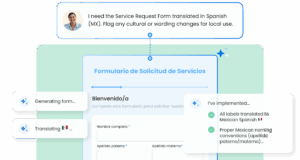FormAssembly recently presented a webinar in partnership with Salesforce Ben during which panelists, Dixon Blue, Senior Account Solution Engineer at Salesforce; Peter Bernardi, Chief Executive Officer at Elevate Actual; and Kayla Condello, Knowledge and Training Manager at FormAssembly, discussed the importance of data cleanliness.
The presentation provided the audience with a deep dive into what clean data means in 2025, how to format data for AI and Salesforce’s Data Cloud, and included a demonstration of how to put all of the best practices mentioned into action in a FormAssembly workflow.
Read on for a detailed recap of the webinar or watch the replay on-demand.
What Clean Data Means in 2025
In the world of data collection, garbage in will always mean garbage out. Without clean data at your disposal, the time and effort put into making sense of data becomes expensive guess work.
FormAssembly recently surveyed 400+ data leaders to get their take on what is getting in the way of clean, usable data. The resulting report, Data Collection in 2025, provided some stunning insight into what the problems are and how they can be solved.
Nearly all survey respondents reported that manual processes are causing inefficiencies at their organization. Furthermore, nearly all believe that data automation is the answer to solving those inefficiencies. And while this is somewhat true, panelist Kayla Condello summed up the truth of this sentiment well: “At the end of the day, automation won’t fix bad data – it will just move it around faster.”
So, with 80% of data leaders seeing data quality issues as they attempt to scale their data collection, how can automation actually help?
There is a human cost to manual data collection. It eats into IT teams’ bandwidth, it introduces a higher likelihood of errors in data, it hampers scalability, and it wastes time – on average, respondents to the Data Collection in 2025 survey reported losing more than 15 hours a week to manual data collection.
Automation yields clear benefits against these costs; respondents who use automation report saving up to 10 hours per week.
Clean, reliable data has a ripple effect: it clears the way for all of the other things a team may want to build. When data isn’t reliable, the downstream impacts are severe – broken processes, bad customer experience, struggles with reporting, and misformating for AI and Salesforce Data Cloud are just a few examples, not to mention the loss of time.
Data in 2025 needs to be consistent, complete, correctly formatted, and available to all who may need to use it. FormAssembly has a few suggestions for how to achieve this at your organization:
- Make use of required fields for your forms
- Be sure to validate form fields
- Monitor data flow closely
As Kayla stated, “Good data doesn’t just happen; you have to build for it.”
Data Formatting for AI and Data Cloud
People and AI both rely on relevant, trusted data to do their jobs. Your data foundation is essential for driving enterprise success.
AI becomes tremendously valuable when it works together with people to drive results; it becomes even more critical as the world moves towards regular use of agents.
We are now in the third wave of AI with assistive and autonomous agents widely available. As we keep evolving, data will become more and more critical for success when using these agents.
More often than not, enterprise data is siloed, fragmented, and difficult to activate. Dixon of Salesforce shared that “71% of company applications are disconnected from one another” and that “90% of data generated by organizations is unstructured.” This is a problem for many reasons, not the least of which being that AI lacks trusted context when data is siloed and unstructured.
Enter, Salesforce Data Cloud.
Data Cloud is the trusted foundation that fuels Salesforce Customer 360 and Agentforce. It is built directly into Salesforce and provides the following benefits:
- Deep platform integration with Customer 360
- Trusted and contextual data for Agentforce
- Autonomous actions within the flow of work
Data Cloud takes structured and unstructured data and brings it together to synthesize 360 views of customer data. This level of integration is invaluable for organizations who look to their data to help them achieve their goals; unless you can do something with your data, it is not that useful. And if it is not providing you with a holistic view of what it is that you need to see, it is not benefiting you.
Data Cloud’s 360 view enables users to:
- Route leads with product usage data
- Craft onboarding journeys using web activity
- Issue alerts based on order data
- And so much more!
In combination with FormAssembly’s leading data collection platform, Data Cloud can provide organizations with everything they need to connect disparate data sources across their organization and harmonize profiles that can be activated anywhere, securely and compliantly.
Final thoughts
AI is a tool that organizations now have in their belt that can be leveraged to achieve specific outcomes, such as automation. There is a common misconception out there that AI is a 100% rip and replace of human intelligence – that is not the case! In reality, AI should be blended with traditional human roles and be used to empower people to do their jobs better. As Dixon posed during the webinar, the question that should be asked is, “Where are we trying to go, and how will using AI in this situation help us get there better than something else might?”
In summary, clean data unlocks flexibility. The cleaner and better your data, and the more intelligently it is connected within your organization, the more you can do with it.

